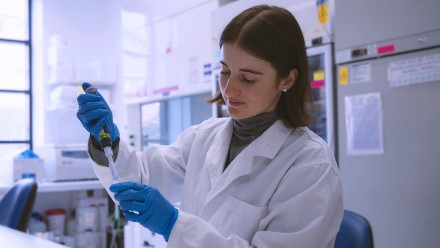Professor Ian Cockburn

Contacts
2014-2018: Australian Research Council discovery grant (DP150102883): To investigate the roles of a novel family of transporters in Apicomplexan biology ($560,000)
2014-2015: Perpetual Foundation (FR2014/1152): Testing of a novel attenuated parasite vaccine ($200,000)
2014: Ian Potter Foundation (32616): To support the purchase of a multiphoton microscope for intravital imaging studies ($50,000)
Research interests
Research and Professional Experience
The main focus of my research is understanding T cell responses to infection with Plasmodium, the malaria parasite. It has long been known that immunization with irradiated parasites (which do not cause infection) can induce sterile immunity against live parasites injected by infected mosquitoes. A large part of this vaccine-like protection is mediated by CD8+ T cells which can kill parasite infected hepatocytes in the liver. My research addresses a number of critical questions about how protective T cell responses work.
1. How do irradiated parasites induce such an effective CD8+ T cell response? Prior to immunization, irradiated parasites have to be dissected out of infected mosquitoes - this probably makes them an unfeasible real-world vaccine. However by learning how parasites can induce protective CD8+ T cells we can learn what features a vaccine should have. We have discovered that irradiated parasites induce the immune system to retain antigen for a period of up to two months. In this time the persisting Plasmodium antigens can continually stimulate and help the expansion of malaria specific CD8+ T cells and thus maximize the immune response.
2. What molecules are the targets of malaria-protective immune responses?The malaria parasite has around 5000 genes, which means many molecules could potentially be targets of the immune response. However not all proteins will be presented to CD8+ T cells - a process that is required to initiate an immune response. A critical question is then is "how does the immune system acquire and process antigens from malaria parasites?" Using a novel transgenic system to track antigen presentation we have found that the critical targets of protective immunity (i.e. potential vaccine candidates) are those molecules secreted out of the parasite and into the cytosol of the infected hepatocyte. These proteins can then be processed and presented to CD8+ T cells by the host cell. A critical area for future work will be determining which molecules are secreted and why.
3. How do effector CD8+ T cells find and eliminate infected hepatocytes? As an infected mosquito usually injects fewer that 100 parasites, the proportion of infected cells in the liver is tiny. Nonetheless CD8+ T cells are capable of finding these parasites and killing them before they have a chance to initiate a clinical infection. We would like to know how this process works. In collaboration with colleagues at the Instiut Pasteur (Paris, France) we are developing intra-vital imaging techniques to track the behaviour of T cells in the infected liver and understand the events surrounding parasite elimination by CD8+ T cells.
Groups
Projects
- Researcher, RNA-binding proteins rewire transcriptomes during immune cell differentiation
- Supervisor, B cell responses to malaria
- Supervisor, T cell responses to malaria
- Supervisor, Why do live pathogens make better vaccines?
- Prabhu, S, Cockburn, I & Garcia de Vinuesa, C 2018, 'HIV Immunogens: Affinity Is Key', Immunity, vol. 48, no. 1, pp. 11-13pp.
- Cockburn, I & Seder, R 2018, 'Malaria prevention: from immunological concepts to effective vaccines and protective antibodies', Nature Immunology, vol. 19, pp. 1199-1211pp.
- Li, Y, Gautam, V, Bruestle, A et al. 2017, 'Flexible polygon-mirror based laser scanning microscope platform for multiphoton in-vivo imaging', Journal of Biophotonics, vol. 10, no. 11, pp. 1526-1537.
- Papa, I, Saliba, D, Ponzoni, M et al. 2017, 'TFH-derived dopamine accelerates productive synapses in germinal centres', Nature, vol. 547, no. 7663, pp. 318+.
- Fisher, C, Sutton, H, Kaczmarski, J et al. 2017, 'T-dependent B cell responses to Plasmodium induce antibodies that form a high-avidity multivalent complex with the circumsporozoite protein', PLoS Pathogens, vol. 13, no. 7, pp. 23pp.
- Sutton, H, Pepper, M & Cockburn, I 2017, 'Embracing diversity gives antibodies the power to bind', Immunology and Cell Biology, vol. 95, no. 10, pp. 862-863pp.
- McNamara, H, Cai, Y, Wagle, M, Sontani, I, Roots, CM, Misoge, LA, O'Connor, JH, Sutton, HJ, Ganusov, VV, Heath, WR, Bertolino, P, Goodnow, CC, Parish, IA, Enders, A and I. Cockburn. 2017, 'Up-regulation of LFA-1 allows liver-resident memory T cells to patrol and remain in the hepatic sinusoids', Science Immunology, vol. 2, no. 9, pp. 1-10pp.
- Rajendran, E, Hapuarachchi, S, Miller, C et al 2017, 'Cationic amino acid transporters play key roles in the survival and transmission of apicomplexan parasites', Nature Communications, 8:14455. doi: 10.1038/ncomms14455.
- Li, Y, Bruestle, A, Gautam, V et al. 2016, 'High speed multiphoton imaging', SPIE Biophotonics Australasia 2016, ed. M R Hutchinson & E M Goldys, SPIE - The International Society for Optical Engineering, Bellingham, United States, pp. 5pp.
- Cockburn, I & Zavala, F 2016, 'Dendritic cell function and antigen presentation in malaria', Current Opinion in Immunology, vol. 40, pp. 1-6pp.
- McNamara, H & Cockburn, I 2016, 'The three Rs: Recruitment, Retention and Residence of leukocytes in the liver', Clinical and Translational Immunology, vol. 5, no. 12, pp. e123-e123.
- Raja, A, Cai, Y, Reiman, J et al 2016, 'Chemically attenuated blood-stage Plasmodium yoelii parasites induce long-lived and strain-transcending protection', Infection and Immunity, vol. 84, no. 8, pp. 2274-2288.
- Raja, A, Cai, Y, Reiman, J et al 2016, 'Chemically attenuated blood-stage Plasmodium yoelii parasites induce long-lived and strain-transcending protection', Infection and Immunity, vol. 84, no. 8, pp. 2274-2288.
- Fernandez-Ruiz, D, Ng, W, Holz , L et al. 2016, 'Liver-Resident Memory CD8(+) T Cells Form a Front-Line Defense against Malaria Liver-Stage Infection', Immunity, vol. 45, no. 4, pp. 889-902.
- Hortle, E, Nijagal, B, Bauer, D et al 2016, 'Adenosine monophosphate deaminase 3 activation shortens erythrocyte half-life and provides malaria resistance in mice', https://www.ncbi.nlm.nih.gov/pubmed/27465915.
- Bijker, E, Nganou-Makamdop, K, van Gemert, G et al 2015, 'Studying the effect of chloroquine on sporozoite-induced protection and immune responses in Plasmodium berghei malaria', Malaria Journal, vol. 14, pp. 130-130.
- Radtke, A, Kastenmuller, W, Espinosa, D et al 2015, 'Lymph-Node Resident CD8 alpha(+) Dendritic Cells Capture Antigens from Migratory Malaria Sporozoites and Induce CD8(+) T Cell Responses', PLoS Pathogens, vol. 11, no. 2, pp. e1004637-e1004637.
- Kelemen, R, He, G, Woo, H et al 2014, 'Classification of T cell movement tracks allows for prediction of cell function', International Journal of Computational Biology and Drug Design, vol. 7, no. 2-3, pp. 113-129.
- Cockburn, I, Tse, S & Zavala, F 2014, 'CD8(+) T Cells Eliminate Liver-Stage Plasmodium berghei Parasites without Detectable Bystander Effect', Infection and Immunity, vol. 82, no. 4, pp. 1460-1464.
- Tse, S, Radtke, A, Espinosa, D et al 2014, 'The Chemokine Receptor CXCR6 Is Required for the Maintenance of Liver Memory CD8(+) T Cells Specific for Infectious Pathogens', Journal of Infectious Diseases, vol. 210, no. 9, pp. 1508-1516.
- Dups, J, Pepper, M & Cockburn, I 2014, 'Antibody and B cell responses to Plasmodium sporozoites', Frontiers in Microbiology, vol. 5, no. Article 625, pp. 1-7.
- Cockburn, I, Tse, S, Zhang, H et al 2013, 'Unique transcriptional profile of liver-resident memory CD8(+) T cells induced by immunization with malaria sporozoites', Genes and Immunity, vol. 14, no. 5, pp. 302-309.
- Cockburn, I 2013, 'Chimeric Parasites as Tools to Study Plasmodium Immunology and assess Malaria Vaccines', in Robert Menard (ed.), Malaria: Methods and Protocols, Humana Press, USA, pp. 465-479.
- Menard, R, Tavares, J, Cockburn, I et al 2013, 'Looking under the skin: the first steps in malarial infection and immunity', Nature Reviews Microbiology, vol. 11, no. 10, pp. 701-712.
- Cockburn, I, Amino, R, Kelemen, R et al 2013, 'In vivo imaging of CD8(+) T cell-mediated elimination of malaria liver stages', PNAS - Proceedings of the National Academy of Sciences of the United States of America, vol. 110, no. 22, pp. 9090-9095.
- Cockburn, I, Tse, S, Radtke, A et al 2011, 'Dendritic Cells and Hepatocytes Use Distinct Pathways to Process Protective Antigen from Plasmodium in vivo', PLoS Pathogens, vol. 7, no. 3, pp. e1001318-e1001318.
- Cockburn, I, Chen, Y, Overstreet, M et al 2010, 'Prolonged Antigen Presentation Is Required for Optimal CD8+ T Cell Responses against Malaria Liver Stage Parasites', PLoS Pathogens, vol. 6, no. 5, pp. e1000877-e1000877.
- Cockburn IA, Chakravarty S, Overstreet MG, GarcÃa-Sastre A, Zavala FJ (2008) Immunol. 180(1):64-71
- Srivastava K, Cockburn IA, Swaim A, Thompson LE, Tripathi A, Fletcher CA, Shirk EM, Sun H, Kowalska MA, Fox-Talbot K, Sullivan D, Zavala F, Morrell CN (2008) Cell Host Microbe. 14;4(2):179-87.
- Chakravarty S, Cockburn IA, Kuk S, Overstreet MG, Sacci JB, Zavala F (2007) Nat Med.13(9):1035-41
- Cockburn IA, Mackinnon MJ, O'Donnell A, Allen SJ, Moulds JM, Baisor M, Bockarie M, Reeder JC, Rowe JA. (2004) Proc Natl Acad Sci U S A. 101(1):272-7







